分類 / Names
俗名 | 同種異名 | Catalog of Fishes(屬, 種) | ITIS | CoL | WoRMS | Cloffa
Elasmobranchii
板鰓亞綱 (鯊魚與魟魚) (sharks and rays) >
Lamniformes (Mackerel sharks)
鼠鯊目 (Mackerel sharks) >
Lamnidae (Mackerel sharks or white shark)
鼠鯊科 (Mackerel sharks or white shark)
Etymology: Carcharodon: carchar-, presumably referring to Carcharias (Odontaspidae); odon (Gr.), tooth, “Teeth as in Carchari[a]s, serrated on both edges”. (See ETYFish); carcharias: From the Ancient Greek karkharías, shark, derived from kárkharos, sharp or jagged, referring to its teeth (“dentibus serratus”). (See ETYFish).
More on author: Linnaeus.
Environment: milieu / climate zone / depth range / distribution range
生態學
海洋; 半鹹淡水; 海洋洄游的 (Ref. 51243); 深度上下限 0 - 1200 m (Ref. 106604), usually 0 - 250 m (Ref. 55270). 亞熱帶的; 61°N - 58°S, 180°W - 180°E
Worldwide. Very wide-ranging in most oceans; among the greatest habitat and geographic range of any fish, tolerating temperatures of 5°-25°C.
四海為家的人, 大部份南北溫帶。 西大西洋: 加拿大紐芬蘭到阿根廷; 也墨西哥灣北方部,巴哈馬,古巴與小安地列斯群島.(參考文獻 26938) 東大西洋: 法國到南非, 包括地中海。 印度洋: 紅海,塞錫爾群島, 南非; 也留尼旺島與模里西斯.(參考文獻 33390) 西太平洋: 西伯利亞到紐西蘭與馬紹爾群島; 也澳洲南方部.(參考文獻 26938) 中太平洋: 夏威夷。 東太平洋: 阿拉斯加到智利。 國際間的買賣合作, 澳洲 ( 引用 附錄 3, 自從 28.5.2003 以後; 公分 附錄 I 與 2).
Length at first maturity / 大小 / 重量 / 年齡
Maturity: Lm 475.0, range 450 - 500 cm
Max length : 640 cm TL 雄魚/尚未辨別雌雄; (Ref. 12489); 最大體重: 0.00 g; 最大年齡: 36 年 (Ref. 31395)
背棘 (總數): 0; 背的軟條 (總數): 0; 臀棘 0; 臀鰭軟條: 0. A huge, spindle-shaped shark with conspicuous black eyes, a blunt, conical snout and large, triangular, saw-edged teeth (Ref. 5578). First dorsal-fin origin usually over the pectoral-fin inner margins (Ref. 43278, 6871). Caudal fin crescentic (Ref. 247). Lead-grey to brown or black above, lighter on sides, and abruptly white below (Ref. 6851). Black spot at rear pectoral fin base (Ref. 6851).
極大, 紡錘形的鯊魚有顯著的黑眼珠,一個鈍又錐形吻與大的﹐三角形的﹐和邊緣鋸狀的齒.(參考文獻 5578) 第一背鰭起源通常在胸鰭內緣上面。 (參考文獻 43278,6871) 尾鰭新月形的.(參考文獻 247) 鉛灰色到褐色或黑色的上方, 兩邊顏色較淡, 與腹面醒目的白色.(參考文獻 6851) 在後面的胸鰭基底的黑色斑點.(參考文獻 6851)
Primarily a coastal and offshore inhabitant of continental and insular shelves, but may also occur off oceanic islands far from land (Ref. 247, 43278, 58302). Often close inshore to the surf line and even penetrates shallow bays (Ref. 247). Maximum depth of 700 fathoms (or 1280 m) reported by Bigelow & Schroeder, 1948 is erroneous (Francis et al., 2012 in Ref. 106604). Pelagic, capable of migration across oceanic regions (Ref. 58302). Usually solitary or in pairs but can be found in feeding aggregations of 10 or more; does not form schools (Ref. 247). Feeds on bony fishes, sharks, rays, seals, dolphins and porpoises, sea birds, carrion, squid, octopi and crabs (Ref. 5578) and whales (Ref. 32140). Ovoviviparous, embryos feeding on yolk sac and other ova produced by the mother (Ref. 43278, 50449). Number of young born per litter, 7 (Ref. 31395) to 14 (Ref. 26346). Reported by some experts to attack humans which they mistake for their normal prey (Ref. 47). Most attacks occur in estuaries. Caught by big-game anglers and line boats for its jaws (Ref. 5578). Reported to cause poisoning (Ref. 4690). Flesh is utilized fresh, dried-salted, and smoked for human consumption, the skin for leather, liver for oil, carcass for fishmeal, fins for shark-fin soup, and teeth and jaws for decorations (Ref. 13574). Maximum total length is leading to much speculation and some measurements are found to be doubtful. Possibly to 6.4 m or more in length (Ref. 43278), considered the world's largest predator with a broad prey spectrum. The record of 10.98 m is incorrect (Ref. 13574). Maximum total length for male from Ref. 91029. Sometimes considered the most dangerous shark in the world (Ref. 26938).
主要地一個大陸棚與島嶼棚的海岸與外海棲居動物, 也但是可能出現大洋性島嶼外遠離土地.(參考文獻 247,58302) 時常近岸到碎浪區甚至深入淺灣.(參考文獻 247) 大洋性, 能夠橫過大洋性的區域的遷移.(參考文獻 58302) 通常獨居性的或成對但是在 10個或更多的覓食群集中被發現於; 不會形成魚群.(參考文獻 247) 吃硬骨魚類,鯊魚,魟,海豹,海豚與鼠海豚,海鳥,腐肉,烏賊,章魚與螃蟹 (參考文獻 5578) 與鯨。 (參考文獻 32140) 卵胎生的, 胚胎吃產生於母親的卵黃囊與其他的卵.(參考文獻 50449) 每胎被出生的幼魚數目, 7(參考文獻 31395) 到 14.(參考文獻 26346) 藉著一些專家報告攻擊人類他們誤認為他們的正常獵物那一個。 (參考文獻 47) 大多數的攻擊出現在河口。 對於它的顎被大-比賽垂釣者與線船捕獲.。 (參考文獻 5578) 報告引起毒害。 (參考文獻 4690) 肉是生鮮利用,乾燥鹽醃, 而且煙燻.供人類消費,皮膚用做皮革,肝臟用於製造魚肝油,殘骸用於魚粉,鰭用於魚翅湯與齒與顎用於裝飾。 (參考文獻 13574) 可能地到 8 公尺長, 被認為是世界最大的掠食者具有一個寬的獵食幅度。 10.98 公尺的記錄是不正確的。 (參考文獻 13574) 有時被認為是最危險的鯊魚世界上。 (參考文獻 26938)
Life cycle and mating behavior
成熟度 | 繁殖 | 產卵場 | 卵 | 孕卵數 | 仔魚
Exhibit ovoviparity (aplacental viviparity), with embryos feeding on other ova produced by the mother (oophagy) after the yolk sac is absorbed (Ref. 50449). Up to 10, possibly 14 young born at 120-150 cm (Ref. 26346). Distinct pairing with embrace (Ref. 205). Male and female may swim in parallel while copulating (Ref. 28042, 49562).四海為家的人, 大部份南北溫帶。 西大西洋: 加拿大紐芬蘭到阿根廷; 也墨西哥灣北方部,巴哈馬,古巴與小安地列斯群島.(參考文獻 26938) 東大西洋: 法國到南非, 包括地中海。 印度洋: 紅海,塞錫爾群島, 南非; 也留尼旺島與模里西斯.(參考文獻 33390) 西太平洋: 西伯利亞到紐西蘭與馬紹爾群島; 也澳洲南方部.(參考文獻 26938) 中太平洋: 夏威夷。 東太平洋: 阿拉斯加到智利。 國際間的買賣合作, 澳洲 ( 引用 附錄 3, 自從 28.5.2003 以後; 公分 附錄 I 與 2).
Compagno, L.J.V., 1984. FAO Species Catalogue. Vol. 4. Sharks of the world. An annotated and illustrated catalogue of shark species known to date. Part 1 - Hexanchiformes to Lamniformes. FAO Fish. Synop. 125(4/1):1-249. Rome, FAO. (Ref. 247)
人類使用
漁業: 低經濟; 游釣魚種: 是的
更多資訊
參考文獻養殖養殖資訊品種遺傳學Electrophoreses遺傳率疾病加工NutrientsMass conversion
工具
特別的報告
下載 XML
網路資源
Estimates based on models
Preferred temperature (Ref.
123201): 11.3 - 24.9, mean 18.1 °C (based on 4368 cells).
Phylogenetic diversity index (Ref.
82804): PD
50 = 1.0313 [Uniqueness, from 0.5 = low to 2.0 = high].
Bayesian length-weight: a=0.00871 (0.00623 - 0.01217), b=3.05 (2.96 - 3.14), in cm total length, based on LWR estimates for this species (Ref.
93245).
營養階層 (Ref.
69278): 4.5 ±0.4 se; based on diet studies.
回復力 (Ref.
120179): 非常低的, 最小族群倍增時間超過14 年 (K=0.06; tm=8-12; tmax=36; Fec=7).
Fishing Vulnerability (Ref.
59153): Very high vulnerability (86 of 100).
Climate Vulnerability (Ref.
125649): High vulnerability (60 of 100).
